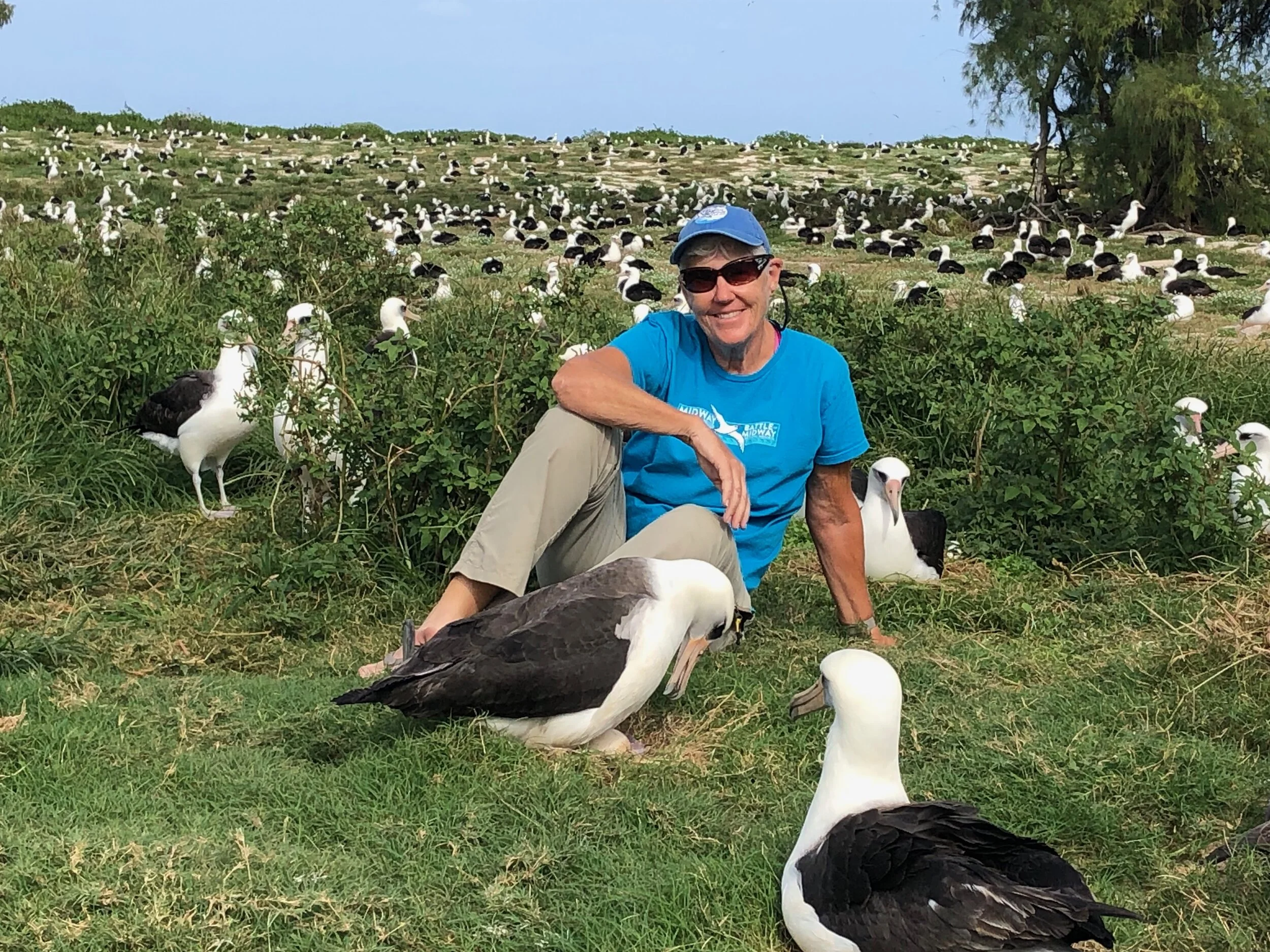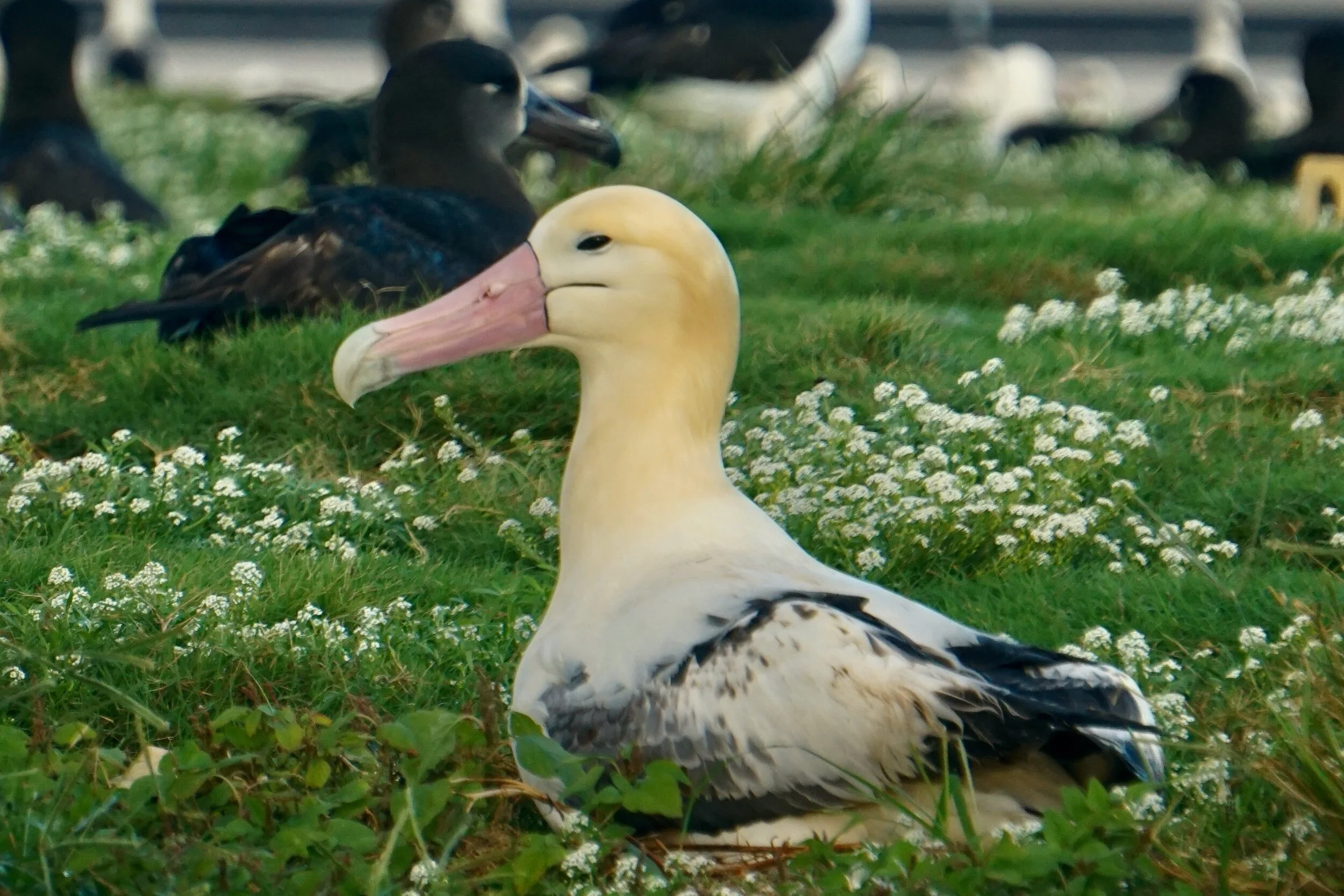Wisdom’s a Mom Again: World’s Oldest Wild Bird is One in a Million (Younger) Mōlī Parents
By Hob Osterlund, Safina Center Fellow
Louise Barnfield. Photo: Elizabeth Rave
Louise Barnfield is one of those people you like straight off. She’s fit and friendly and funny in that perfect wry British sort of way. After decades working with the Oracle Corporation—most recently as a Principal Product Manager—she retired and moved with her husband to Kaua’i. She now volunteers at two national wildlife refuges (Kīlauea Point and Hanalei) monitoring endangered wetland birds and Laysan albatross. It was love for the albatross (“mōlī” in Hawaiian) that took her to Midway Atoll earlier this year. Every season the nesting birds are counted by an intrepid hard-working crew of volunteers, and 2021 brought its own special challenges. Shortly after she returned I asked her to describe her experience for us.
Hob Osterlund: Welcome back from Midway, Louise. How exciting you were able to participate in the annual albatross count for the third time. Tell us about the build-up to going, and how COVID19 impacted the plans.
Louise Barnfield: For months prior to the count we had Zoom meetings to discuss logistics, equipment and travel. Each year, supplies have to be ordered well in advance and flown from Honolulu on a US Fish & Wildlife Service charter plane that goes to Midway twice a month. This year, as with everything COVID19-related, the entire count was at risk of being canceled completely, but in the end we were able to go with a smaller team. Our team is typically 18 people, but these days the charter is only a nine-seater jet. Last season we were reduced to 13, with two groups flying in two weeks apart. This season, that number was cut even further to just seven, because we all had to quarantine on Midway for two weeks before we could start work.
Landing on the airstrip at Midway and getting to the barracks is unworldly. Please describe your arrival for us.
During albatross season, the charter must land and take off in darkness. Lights are off for landing, so all we see out the windows is the runway lined with ghostly pale shapes of hundreds of albatross nestled on the ground. Usually we are warmly welcomed and driven in the Midway version of a limo (an eight-seater golf cart) to Charlie Barracks. This time the Midway folks kept their distance. We stepped off the plane and stood more than six feet apart. The medic took our temperatures, gave us gloves, a squirt of hand sanitizer and a folder full of quarantine protocols. We each collected our luggage and drove separate carts to our lodgings. I quarantined in a building called Empire Café, which at one time was the Navy’s brig. It’s now a very comfortable detached unit with full kitchen, washer/dryer, everything I needed. That was my home for the full six weeks.
Midway WWII barracks. Photo: Hob Osterlund
The count was already a huge job. How did it go with a much smaller crew? Was the weather crazy?
The three islands that make up Midway Atoll—Sand Island, Eastern Island and Spit—are divided into a total of 61 sectors with boundary lines identified by GPS waypoints and features such old roads and trails. These long-established sectors provide accurate comparisons for sector counts each year. With just seven of us, it would have been impossible to complete a full count of the entire Atoll, so some team members created a prioritized list of sectors. We went with the plan of completing the top priorities, such as counting all the Black-footed albatross, which have far smaller numbers than the Laysan albatross. They are also more at risk of sea rise because they typically nest closer to shorelines. We were very fortunate, however, to get the help of FWS staff and volunteers who joined us during our last couple of weeks. We absolutely could not have accomplished the full count without them.
The weather was mostly pretty good. We needed several days of relatively calm ocean to boat over to Eastern Island. We only had a couple of wet count days while I was there, but during a two-week extension, the team had to cope with some serious stormy weather that forced them to delay the last few sectors of Sand Island. The danger of falling branches in forested areas and strong winds was too great to risk counting. They actually completed the final sector on their last full day on island.
Among the millions of birds at Midway there are two famous birds: Wisdom, a 70-year-old Laysan albatross who’s the oldest-known wild bird in the world, and George, an extremely rare short-tailed albatross. What’s an update on them?
Wisdom’s chick hatched successfully on February 1, just after I left Midway. Her mate, Akeakamai, was on the nest at the time, but Wisdom returned just a couple of days later to greet her latest hatchling. George and his mate Geraldine, the short-tailed albatross pair, also have a healthy chick hatched on or near New Year’s Day.
Wisdomʻs mate Akeakamai incubates their egg. Photo: Hob Osterlund
Tell us a story about a highlight experience while you were there.
We had a special surprise while counting one particular sector. Standing in the middle of a field full of Laysans was a juvenile short-tail albatross. It had been seen briefly in the same area the previous year, so we were delighted to see it had returned. I say “it” because we don’t know whether the bird is male or female. We do, however, know that it’s still quite young because of its dark coloring. Unlike Laysan and black-footed albatross, the short-tailed albatross doesn’t get full adult plumage (with a stunning golden head) until it’s about 15 years old. Short-tails are also much larger than Laysans, so this one looked very impressive standing among smaller relatives. Of course we hope that, like George, it can find a mate and return to Midway Atoll to breed.
Laysan albatross courts with hybrid and Laysan/Black-footed albatross. Photo: Hob Osterlund
What was the final albatross count, and how does that compare to previous years?
We counted over half a million nests: 492,189 Laysan and 26,524 black-footed, plus of course our one very special short-tailed nest. The final count was not the highest ever, but was slightly higher than last year and within the range of variation that we’ve seen over recent years. The numbers do fluctuate, and of course the nest count only considers those birds that arrive to breed each year, so factors such as ocean conditions can affect the number of active nests. While the annual nest census is a valuable measurement, equally important is the overall reproductive success of those nests. There are so many factors that might play a part, from weather conditions including inundation events, food supply, predators and parasites. Last season the reproductive success was depressingly low. However, as Wisdom has proved, these birds can have a long life span, so a failure in one particular year doesn’t necessarily have a huge effect on the overall population. Adult survivorship is therefore a better measurement of population health. So staff and volunteers of the Midway Atoll Wildlife Refuge carefully monitor both reproduction success and survivorship in selected plots across the Atoll.
Short-tailed albatross. Photo: Louise Barnfield
Mice have been known to predate on nesting albatross at Midway, and a mouse eradication project has been planned and postponed for a couple of years. Did you see evidence of predation this year, and is the eradication project now planned for 2022?
There are even more mice than I remembered from past visits, but thankfully not nearly the number of attacks that were first noticed in hatch years 2016 and 2017. We did spot one injury while we were counting, and reported it to staff, so mouse attacks still are a big concern. Preparations for the mouse eradication project had already been well underway for 2021 but unfortunately, yes, because of COVID19 it has now been postponed to 2022.
What would you like the world to know about Midway Atoll? How can people help the work being done there?
Roughly 99% of the world’s population of Laysan and black-footed albatross nest in the Northwestern Hawaiian islands, and the vast majority of those nest specifically on Midway Atoll. Every year Midway is losing critical land mass. With a maximum altitude of only 42 feet, it is constantly threatened by sea level rise, increasingly severe storm events, and powerful storm surges that destroy more and more nests each season.
The USFWS works hard to protect these species, as well as other natives that inhabit the islands, including endangered monk seals, green sea turtles, and many other seabirds. They also support vital projects that are establishing colonies of albatross in safer locations. Following a successful translocation project started by Pacific Rim Conservation (PRC) in 2015, Laysans are now returning to their hatch sites at a refuge on the north shore of Oʻahu, where PRC is conducting a similar program for black-footed albatross. This year, for the first time, PRC translocated black-footed albatross from Midway to a refuge high on a bluff on Guadalupe Island, Mexico.
All these projects depend on volunteers and donations to continue the vital work of monitoring populations, and establishing alternative sites to protect these birds as they lose their original habitat. I’d encourage everyone to learn more about, and if possible contribute to, the conservation efforts of non-profit organizations such as Friends of Midway Atoll and Pacific Rim Conservation.
Midway volunteers. Photo: Jon Brack






